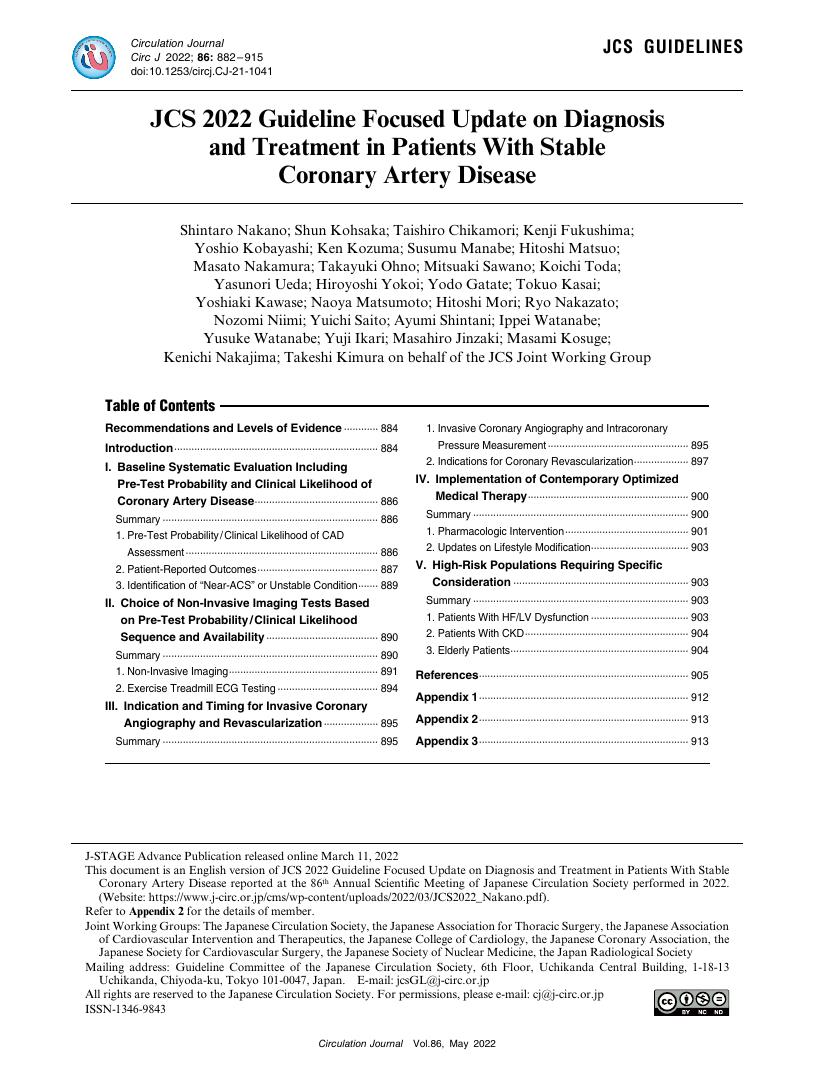17 0 0 0 OA Contemporary Management of Stable Coronary Artery Disease ― Implications of the ISCHEMIA Trial ―
- 著者
- Shun Kohsaka Kenji Fukushima Ippei Watanabe Susumu Manabe Nozomi Niimi Yodo Gatate Mitsuaki Sawano Shintaro Nakano
- 出版者
- The Japanese Circulation Society
- 雑誌
- Circulation Journal (ISSN:13469843)
- 巻号頁・発行日
- pp.CJ-21-0345, (Released:2021-06-18)
- 参考文献数
- 68
- 被引用文献数
- 3
Coronary artery disease (CAD) remains a leading cause of mortality and morbidity in developed countries. Although urgent revascularization is the cornerstone of management of acute coronary syndrome (ACS), for patients with stable CAD recent large-scale clinical trials indicate that a mechanical ‘fix’ of a narrowed artery is not obviously beneficial; ACS and stable CAD are increasingly recognized as different clinical entities. We review the perspectives on (1) modifying the diagnostic pathway of stable CAD with the incorporation of modern estimates of pretest probability, (2) non-imaging evaluations based on their availability, (3) the optimal timing of invasive coronary angiography and revascularization, and (4) the implementation of medical therapy during the work-up.
11 0 0 0 OA JCS 2022 Guideline Focused Update on Diagnosis and Treatment in Patients With Stable Coronary Artery Disease
- 著者
- Shintaro Nakano Shun Kohsaka Taishiro Chikamori Kenji Fukushima Yoshio Kobayashi Ken Kozuma Susumu Manabe Hitoshi Matsuo Masato Nakamura Takayuki Ohno Mitsuaki Sawano Koichi Toda Yasunori Ueda Hiroyoshi Yokoi Yodo Gatate Tokuo Kasai Yoshiaki Kawase Naoya Matsumoto Hitoshi Mori Ryo Nakazato Nozomi Niimi Yuichi Saito Ayumi Shintani Ippei Watanabe Yusuke Watanabe Yuji Ikari Masahiro Jinzaki Masami Kosuge Kenichi Nakajima Takeshi Kimura on behalf of the JCS Joint Working Group
- 出版者
- The Japanese Circulation Society
- 雑誌
- Circulation Journal (ISSN:13469843)
- 巻号頁・発行日
- pp.CJ-21-1041, (Released:2022-03-11)
- 参考文献数
- 245
- 被引用文献数
- 40
- 著者
- Takanori Ohata Nozomi Niimi Yasuyuki Shiraishi Fumiko Nakatsu Ichiro Umemura Takashi Kohno Yuji Nagatomo Makoto Takei Tomohiko Ono Munehisa Sakamoto Shintaro Nakano Keiichi Fukuda Shun Kohsaka Tsutomu Yoshikawa
- 出版者
- The Japanese Circulation Society
- 雑誌
- Circulation Journal (ISSN:13469843)
- 巻号頁・発行日
- pp.CJ-23-0356, (Released:2023-10-31)
- 参考文献数
- 43
- 被引用文献数
- 1
Background: Despite recommendations from clinical practice guidelines to initiate and titrate guideline-directed medical therapy (GDMT) during their hospitalization, patients with acute heart failure (AHF) are frequently undertreated. In this study we aimed to clarify GDMT implementation and titration rates, as well as the long-term outcomes, in hospitalized AHF patients.Methods and Results: Among 3,164 consecutive hospitalized AHF patients included in a Japanese multicenter registry, 1,400 (44.2%) with ejection fraction ≤40% were analyzed. We assessed GDMT dosage (β-blockers, renin-angiotensin inhibitors, and mineralocorticoid-receptor antagonists) at admission and discharge, examined the contributing factors for up-titration, and evaluated associations between drug initiation/up-titration and 1-year post-discharge all-cause death and rehospitalization for HF via propensity score matching. The mean age of the patients was 71.5 years and 30.7% were female. Overall, 1,051 patients (75.0%) were deemed eligible for GDMT, based on their baseline vital signs, renal function, and electrolyte values. At discharge, only 180 patients (17.1%) received GDMT agents up-titrated to >50% of the maximum titrated dose. Up-titration was associated with a lower risk of 1-year clinical outcomes (adjusted hazard ratio: 0.58, 95% confidence interval: 0.35–0.96). Younger age and higher body mass index were significant predictors of drug up-titration.Conclusions: Significant evidence-practice gaps in the use and dose of GDMT remain. Considering the associated favorable outcomes, further efforts to improve its implementation seem crucial.
- 著者
- Shintaro Nakano Shun Kohsaka Taishiro Chikamori Kenji Fukushima Yoshio Kobayashi Ken Kozuma Susumu Manabe Hitoshi Matsuo Masato Nakamura Takayuki Ohno Mitsuaki Sawano Koichi Toda Yasunori Ueda Hiroyoshi Yokoi Yodo Gatate Tokuo Kasai Yoshiaki Kawase Naoya Matsumoto Hitoshi Mori Ryo Nakazato Nozomi Niimi Yuichi Saito Ayumi Shintani Ippei Watanabe Yusuke Watanabe Yuji Ikari Masahiro Jinzaki Masami Kosuge Kenichi Nakajima Takeshi Kimura on behalf of the JCS Joint Working Group
- 出版者
- The Japanese Circulation Society
- 雑誌
- Circulation Journal (ISSN:13469843)
- 巻号頁・発行日
- vol.86, no.5, pp.882-915, 2022-04-25 (Released:2022-04-25)
- 参考文献数
- 245
- 被引用文献数
- 40
